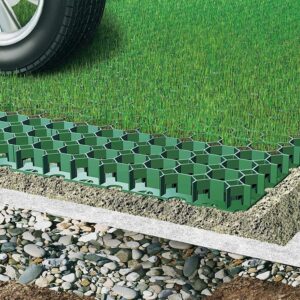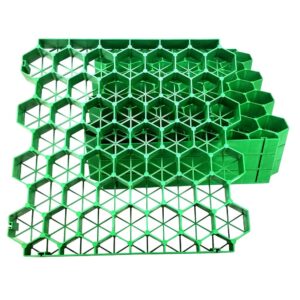What is plastic grass grid
Plastic grass grids are an innovative solution for creating durable and environmentally friendly driveways and parking areas. These grids support grass growth while providing a sturdy surface for vehicles. Made from recycled materials, they offer a sustainable alternative to traditional paving options.
Plastic grass grids are transforming outdoor spaces, offering a blend of durability, environmental responsibility, and aesthetic appeal. Whether you’re reinforcing a driveway, creating a gravel parking area, or designing a permeable paver system, these grids provide unmatched versatility. Let’s dive into why they’re a top choice for homeowners and contractors alike.
Why Choose Plastic Grass Grids?
1. Superior Durability for Heavy-Duty Use
Plastic grass grids are designed to hold heavy loads. They can support up to 20 tonnes per squaremeters in some cases. This makes them great for driveways, parking areas, and fire lanes. Unlike traditional concrete pavers, these grids flex under pressure without cracking, ensuring long-term stability.
2. Eco-Friendly Drainage Solutions
By allowing water to permeate naturally, plastic grids reduce stormwater runoff and prevent flooding. Their open-cell design promotes healthy grass growth while complying with Sustainable Urban Drainage Systems (SUDS).
3. Easy Installation & Customization
With snap-and-lock connectors, grids install quickly on slopes or flat terrain. Cut them to fit curves or obstacles effortlessly. For example, StartSafety’s StartPave system provides pre-assembled pallets. This helps contractors lay 1,000 sq ft per hour.
4. Aesthetic Versatility
Fill grids with gravel, soil, or grass to match your landscape. Brands like [IBRAN](https://www.ibran.com/products/grass-parking-grids) even offer UV-stable, color-matched options for seamless integration.
Applications of Plastic Grass Grids

- – Driveways: Prevent rutting and mud with grids that anchor vehicles on grass or gravel surfaces.
- – Parking Areas: Stabilize gravel parking lots while maintaining permeability.
- – Pathways & Patios: Create decorative walkways with improved drainage.
- – Commercial Use: Ideal for fire lanes, rooftop gardens, and emergency access routes.
How to Install Plastic Grass Grids: A Quick Guide
- Prepare the Base: Excavate the area to a 40mm depth and add a sub-base (e.g., Type 1 MOT) for stability.
- Lay the Grids: Interlock grids using built-in clips. Cut edges as needed for curves.
- Fill the Cells: Use gravel (½” or smaller) for high-traffic zones or soil/grass for green spaces.
- Compact & Finish: Lightly compact the surface for a smooth finish.
Pro Tip: Order 10-15% extra material to account for cuts and adjustments.
Plastic Grids vs. Concrete: Key Advantages
– Lightweight: Easier to transport and install (e.g., Bokk grids weigh 2.4kg vs. 27kg for concrete).
– Cost-Effective: Lower labor costs and no curing time.
– Frost-Resistant: Unlike concrete, plastic won’t crack in freezing temperatures.
For heavy-duty projects, explore
AGTEC’ struck-rated pavers Boost Curb Appeal & Sustainability
Plastic grass grids are a win-win for aesthetics and eco-friendliness.
Brands like Vodaland mix strength with stylish designs.
At the same time, EcoDeck offers great options too, focuses on SUDS compliance for urban projects.
Ready to Transform Your Space?
Plastic grass grids are a great choice for homeowners and contractors.
They work well for driveways, parking areas, and more.
Contact us today for personalized advice or request a quote to start your project!
————————————————————————————————————-
Backlink Integration Examples:
– Learn about SUDS compliance from [House Digest](https://housedigest.com).
– Explore permeable paving trends on [BusinessToMark](https://businesstomark.com).

